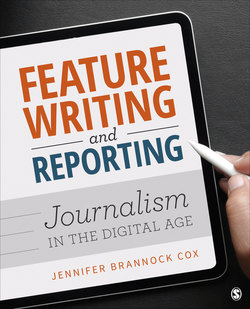Читать книгу Feature Writing and Reporting - Jennifer Brannock Cox - Страница 62
На сайте Литреса книга снята с продажи.
Explainer Features
ОглавлениеFeature stories explaining how to accomplish a certain task or goal tend to be popular with readers because of their relatability. How-to stories, ranging from practical time peg articles to more arbitrary evergreen stories, usually sprout from a question that might be on the minds of people in the community. Practical explainers can provide readers with information they need at a particular time. For example, azcentral.com published “How to Register to Vote in Arizona’s November Election—Don’t Get Left Out” one month before the state’s voter registration deadline. As college students prepared to move back into their residence halls, Buzzfeed published the article “How To: Showcase Your Space,” providing tips for decorating dorm rooms (see Figure 2.7).
Figure 2.7 Using Time Pegs for Story Ideas
Evergreen articles tend to be popular among magazines and address needs specific to their audience. Forbes magazine gears stories toward its readers in the finance and business industries, routinely publishing how-to features examining workplace and consumer questions, such as “How to Boost Your Value in the Workplace” and “How to Help Your Children Minimize Future Student Loan Debt.” Conversely, Teen Vogue, which covers issues important to middle school, high school and early college students, publishes explanatory pieces, including “How to Deal With Seeing Your Ex at School” and “How to Fix Bad Box Hair Dye.”
Explainers can also be used to provide background information or clarification on a topic. These too can be either time sensitive or arbitrary, as illustrated by The New York Times. When a heat wave hit New York City, the newspaper published “Why We All Need to Drink More During Hot Weather Exercise.” One month earlier, “Women Outlive Men: Why Do They Retire Earlier?” explained the issue in an evergreen story.
Writing and reporting an explainer feature is not as simple as voicing your own thoughts on a topic. Successful explainers should be relatable, informative and interesting so readers will want to share them. Here are some tips:
Choose something important to readers, not just to you.NO: Top 10 things that bother me about school.YES: Top 10 student complaints about school.
Be appealing by narrowing your topic.NO: Ways to get in shape for summer.YES: Fun ways to get in shape for summer.
Specify your target audience when possible.NO: Top 10 student hangouts.YES: Top 10 middle school student hangouts in downtown Charlotte.
Transforming explainers from soft news or opinion articles into more newsworthy pieces requires good feature reporting and writing skills. Be sure to get sources to explain their processes and reactions rather than inserting your own opinion. It is also a good idea to get a diverse array of sources. Interview experts who know a lot about the topic, as well as average citizens who might be trying something for the first time. When writing, use emotional quotes and paraphrase facts. Having your sources reflect on their experience with the topic through quotes and thoughtful paraphrasing will resonate more with readers than if the reporter simply tells them how the sources feel. For example:
NO: Pilates became a popular low-impact alternative to yoga for fitness fanatics in the 2000s.
“I dropped two pant sizes during the last year,” yoga enthusiast Mandy Smith said. “I do yoga about four times each week.”
YES: Pilates became a popular low-impact alternative to yoga for fitness fanatics in the 2000s.
Mandy Smith says she enjoys the combination of strength and stretching exercises associated with Pilates. Smith credits weekly classes with helping her drop two pant sizes last year.
“It’s such a wonderful way to relax and sweat at the same time,” she said. “You don’t feel like you’re wearing yourself out, but the results speak for themselves.”
To practice writing and reporting thorough explainers, consider a broad question you can ask people around you: What are your favorite things to do in your town/city? Talk with people on the street, and turn their responses into a news story.
